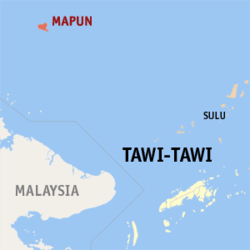Mapun
| Mapun | |
|---|---|
| Municipality | |
 Map of Tawi-Tawi with Mapun highlighted | |
.svg.png) Mapun Location within the Philippines | |
| Coordinates: 07°00′N 118°30′E / 7.000°N 118.500°ECoordinates: 07°00′N 118°30′E / 7.000°N 118.500°E | |
| Country | Philippines |
| Region | Autonomous Region in Muslim Mindanao (ARMM) |
| Province | Tawi-Tawi |
| District | Lone district of Tawi-Tawi |
| Barangays | 15 |
| Government[1] | |
| • Mayor | Kennedy Muksin |
| Area | |
| • Total | 181.29 km2 (70.00 sq mi) |
| Population (2015 census)[2] | |
| • Total | 26,597 |
| • Density | 150/km2 (380/sq mi) |
| Time zone | PST (UTC+8) |
| ZIP code | 7508 |
| IDD : area code | +63 (0)68 |
| Income class | 4th municipal income class |
| PSGC | 157003000 |
| Electorate | 15,250 voters as of 2016 |
Mapun (formerly Cagayan de Tawi-Tawi or Cagayan de Sulu) is a fourth class partially urban municipality in the province of Tawi-Tawi, Philippines.According to the 2015 census, it has a population of 26,597 people.[2]
Mapun is an island municipality in the Sulu Sea[3] on the south-western extreme of the Philippines, located very close to Sabah, Malaysia. The people inhabiting the island are known as Jama Mapun or "people of Mapun". Their dialect is Pullun Mapun, which means "Mapun dialect".
Barangays
Mapun is politically subdivided into 15 barangays.
- Boki
- Duhul Batu
- Guppah
- Iruk-Iruk
- Kompang
- Liyubud (Pob.)
- Lubbak Parang
- Lupa Pula
- Mahalu
- Pawan
- Sapah
- Sikub
- Tabulian
- Tanduan
- Umus Mataha
Demographics
| Population census of Mapun | ||
|---|---|---|
| Year | Pop. | ±% p.a. |
| 1903 | 2,000 | — |
| 1918 | 6,090 | +7.71% |
| 1939 | 6,851 | +0.56% |
| 1948 | 8,824 | +2.85% |
| 1960 | 10,789 | +1.69% |
| 1970 | 12,577 | +1.54% |
| 1975 | 15,892 | +4.80% |
| 1980 | 19,607 | +4.29% |
| 1990 | 19,372 | −0.12% |
| 1995 | 20,716 | +1.26% |
| 2000 | 22,011 | +1.31% |
| 2007 | 29,801 | +4.27% |
| 2010 | 24,168 | −7.34% |
| 2015 | 26,597 | +1.84% |
| Source: Philippine Statistics Authority[2][4][5][6] | ||
Education
- Elementary
- Lupa Pula Pilot School (formerly Lupa Pula Central School) - elementary pupils are primarily from Lupa Pula, Liyubud, and Mahalu.
- Mahalu Elementary School
- Duhul Batu Elementary School
- Sikub Elementary School
- Tabulian Elementary School
- Sapah Elementary School
- Boki Elementary School
- Kompang Elementary School
- Tanduan Elementary School
- Pawan Elementary School
- Guppah Elementary School
- Iruk-Iruk Elementary School
- Umus Mataha Elementary School
- Lubbak Parang Elementary School
- Imam Saat Elementary School
- Secondary
- Notre Dame of Cagayan (NDC) - a private school located in the border of Barangay Lupa Pula and Barangay Mahalu.
- Mindanao State University (MSU) - a public school located in Mahalu
- Tawi-Tawi Academy (TTA) - a private school located in Barangay Guppah
- Tertiary
Mindanao State University Extension - a public school and the only college institution in Mapun. MSU-Extension offers two-year courses.
Majority of those who graduate from high school pursue their studies in other places, most notably Zamboanga City, Palawan, and Bongao.
Mapun Day
Mapun Foundation Day is celebrated by the Jama Mapun every September 5. This week-long celebration starts on September 1, with a parade and then a short program held in Lupa Pula Central School. Various competitions are held during Mapun Day, which includes singing competitions (in English, Tagalog, and Pullun Mapun), dance showdowns (modern dance, folk dance, pangalay, which is a native dance, and lunsay, which is a dance performed during weddings), Azaan competition, Tarasul iban Daman (Mapun's version of declamation and oration), and Leleng, to name a few. Each Barangay has their own representatives in the various events. However, the most popular is the "Budjang Mapun", which is a beauty contest. Each barangay has its own contestant in this event. The winner of the search for "Budjang Mapun" is usually sent to Bongao as Mapun's representative in Budjang Tawi-Tawi, a similar beauty search held in Bongao every Province Day. Every municipality in Tawi-Tawi has its own contestant.
Local legend
According to local legend the Berbalang is indigenous to a small village in the interior of the Island.
See also
References
- ↑ "Official City/Municipal 2013 Election Results". Intramuros, Manila, Philippines: Commission on Elections (COMELEC). 1 July 2013. Retrieved 5 September 2013.
- 1 2 3 Census of Population (2015). "ARMM - Autonomous Region in Muslim Mindanao". Total Population by Province, City, Municipality and Barangay. PSA. Retrieved 20 June 2016.
- ↑ C.Michael Hogan. 2011. Sulu Sea. Encyclopedia of Earth. Eds. P.Saundry & C.J.Cleveland. Washington DC
- ↑ Census of Population and Housing (2010). "ARMM - Autonomous Region in Muslim Mindanao". Total Population by Province, City, Municipality and Barangay. NSO. Retrieved 29 June 2016.
- ↑ Census of Population (1995, 2000 and 2007). "ARMM - Autonomous Region in Muslim Mindanao". Total Population by Province, City and Municipality. NSO. Archived from the original on 11 November 2011.
- ↑ "Province of Tawi‑tawi". Municipality Population Data. Local Water Utilities Administration Research Division. Retrieved 17 December 2016.